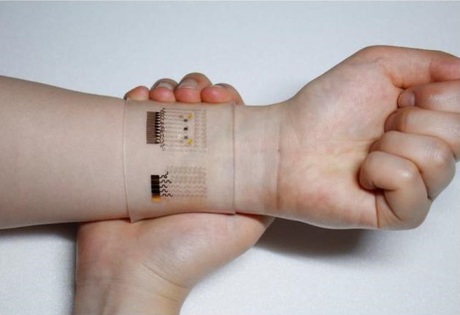Diabetes monitoring through human sweat

Korean scientists have created a wearable patch that allows accurate diabetes monitoring and feedback therapy by using human sweat. Their work has been published in the journal Nature Nanotechnology.
The research team, led by the Center for Nanoparticle Research at the Institute of Basic Science (IBS), created their biomedical device in response to the need for non-invasive, painless and stress-free monitoring of important markers of diabetes. The device features pH and temperature monitoring functions that enable systematic corrections of sweat glucose measurements as the enzyme-based glucose sensor is affected by pH (blood acidity levels) and temperature.
“The patch is applied to the skin where sweat-based glucose monitoring begins on sweat generation,” explained Kim Dae-Hyeong, a co-author on the study. “The humidity sensor monitors the increase in relative humidity (RH). It takes an average of 15 minutes for the sweat-uptake layer of the patch to collect sweat and reach an RH over 80%, at which time glucose and pH measurements are initiated.”
As part of the study, two healthy males participated in tests to demonstrate the sweat-based glucose sensing of the device. Glucose and pH levels of both subjects were recorded; a statistical analysis confirmed the reliable correlation between sweat glucose data from the diabetes patch and those from commercial glucose tests. If abnormally high levels of glucose were detected, a drug was released into a patient’s bloodstream via drug-loaded microneedles.
The team also demonstrated the therapeutic effects by experimenting on diabetic (db/db) mice. Treatment began by applying the device near the abdomen of the db mouse. Microneedles pierced the skin of the mouse and released Metformin, an insulin-regulating drug, into the bloodstream. The group treated with microneedles showed a significant suppression of blood glucose concentrations with respect to control groups.
“Treatment with Metformin through the skin is more efficient than that through the digestive system because the drug is directly introduced into metabolic circulation through the skin,” commented Dae-Hyeong.
The malleable, semitransparent, skin-like appearance of the patch provides easy and comfortable contact with human skin, allowing the sensors to remain unaffected by any skin deformations. This enables stable sensing and efficient drug delivery. The device retains its original sensitivity after multiple uses and used microneedles can be easily replaced with new ones.
“The connection of the device to a portable/wireless power supply and data transmission unit enables the point-of-care treatment of diabetes,” added Dae-Hyeong.
Mini lung organoids could help test new treatments
Scientists have developed a simple method for automated the manufacturing of lung organoids...
Clogged 'drains' in the brain an early sign of Alzheimer’s
'Drains' in the brain, responsible for clearing toxic waste in the organ, tend to get...
World's oldest known RNA extracted from woolly mammoth
The RNA sequences are understood to be the oldest ever recovered, coming from mammoth tissue...





